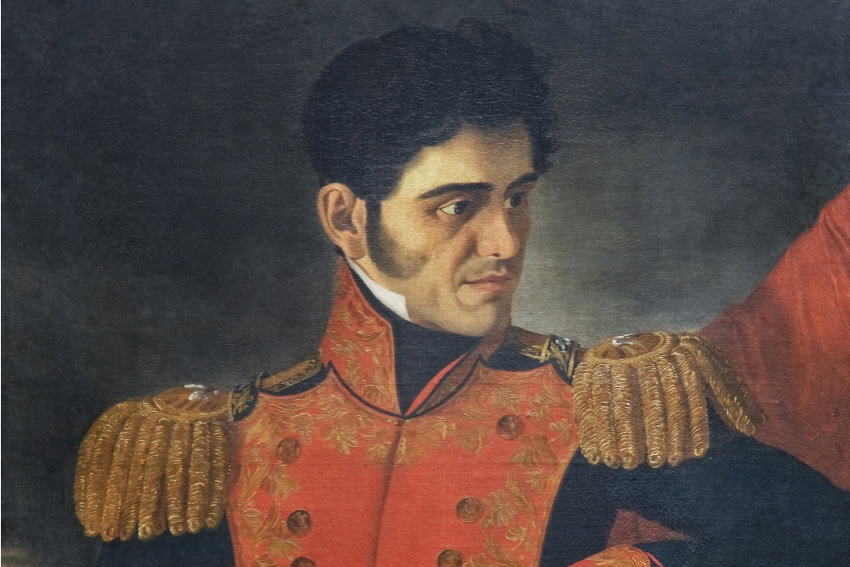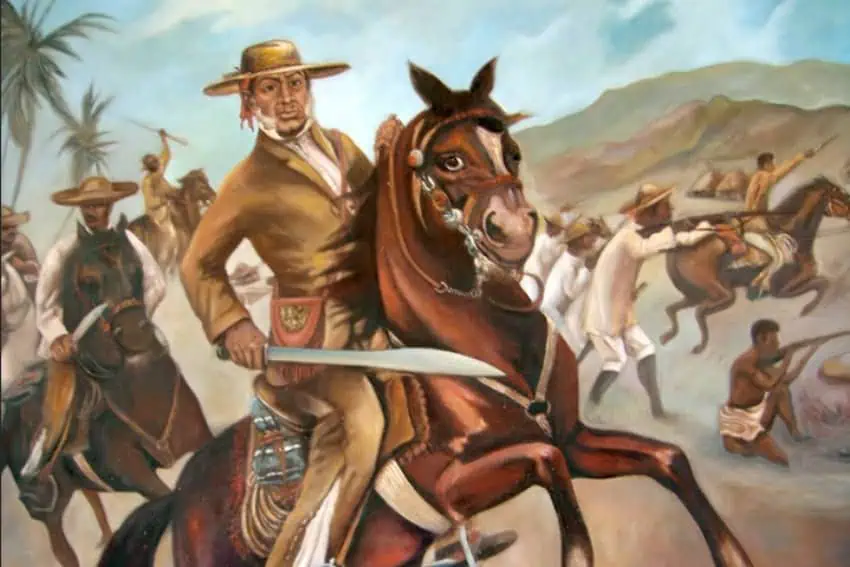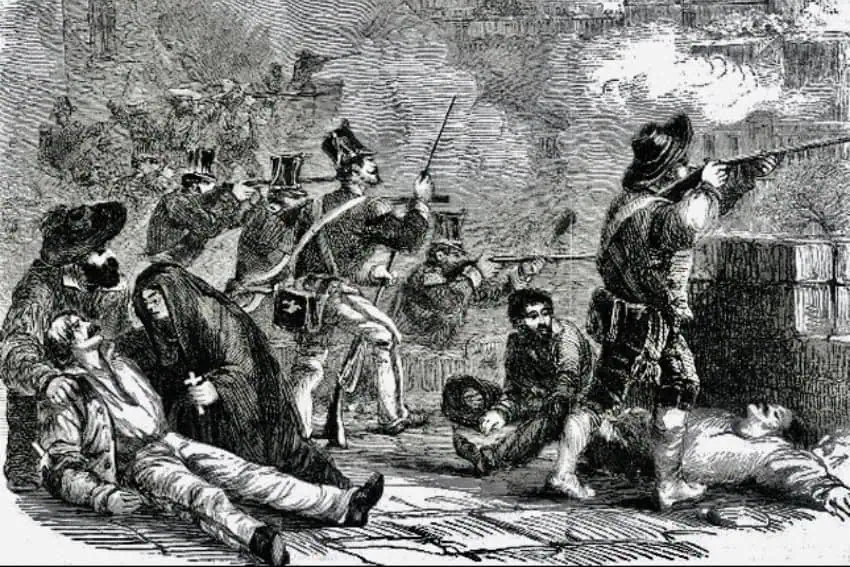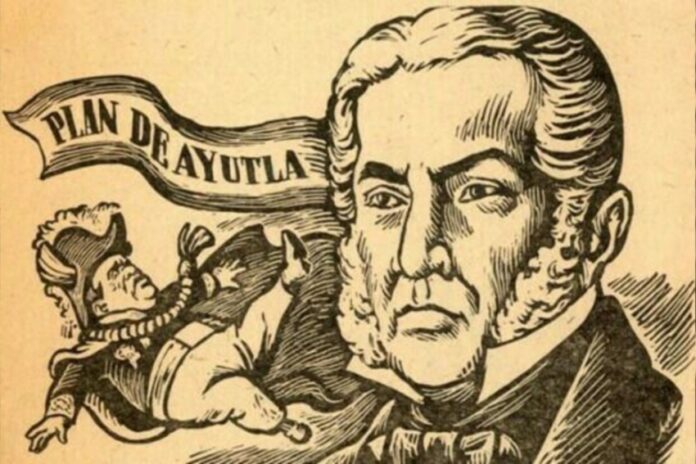On Aug. 12, 1855 — 170 years ago today — Antonio López de Santa Anna officially resigned from his sixth term as Mexico’s president in Perote, Veracruz. Three days earlier, he had slipped out of Mexico City at dawn and fled for his home state, where he would board a ship and leave for yet another exile. Santa Anna had lost and returned to power many times before, and he may have imagined that afternoon that he would soon be back again. But though he did not know it, his chapter in Mexico’s history was closing and another was beginning in his place: the Liberal Reform. It was heading for Mexico City with the insurgents who had toppled Santa Anna in the conflict Mexico remembers as the Ayutla Revolution.
We can’t understand the Ayutla Revolution without understanding the man it overthrew. It would not be right to say that Antonio López de Santa Anna is one of the most controversial figures in Mexican history, historian Patricia Galeana once remarked, because almost everyone agrees that he is one of its most disastrous characters. In recent decades, this view has become more nuanced thanks to the work of researchers like Will Fowler, who has done much to place Santa Anna in his proper context and refute the idea that he was a traitor to Mexico. However, this idea is still widespread. To this day, schoolchildren learn about Santa Anna as the great villain of the early republic, a dictator who betrayed his nation and sold off half the country.

Santa Anna’s historical reputation as a tyrant was solidified during his 1853-1855 period in office — which ended with the Ayutla Revolution. But by the time the revolution broke out, Santa Anna had a decades-long career in politics behind him and had been one of the central figures in national life since the earliest days of independent Mexico.
The age of Santa Anna
Born in Xalapa, Santa Anna joined the Spanish army as a teenager, just in time for the War of Independence to break out. When insurgent leader Vicente Guerrero and the royalist officer Agustín de Iturbide joined forces to achieve independence, Santa Anna changed sides and joined the rebels, becoming famous as the liberator of his home province. It was the first in a long string of political switches during his long career. In the 19th century, Mexico was torn between federalists and centralists, liberals and conservatives, republicans and monarchists. At some point or another, Santa Anna would fight for them all.
It was Santa Anna who first moved to establish a republic, rebelling against the Mexican Empire — the country’s first independent government — and driving Emperor Iturbide into exile. In 1828, after Mexico’s second presidential election, Santa Anna revolted to prevent the inauguration of the conservative winner in favor of his old comrade, the liberal Guerrero. In 1829, he was transformed into a national hero when he defeated Spain’s attempt to recolonize Mexico at the Battle of Tampico.
In 1831, Santa Anna rebelled once more against the conservative government of Anastasio Bustamante, who had overthrown Guerrero, and re-established the constitutional order that he himself had broken in 1828. By this point, the Veracruzano general was popular nationwide and handily won the presidential election of 1833. He preferred, however, to leave the task of governing to his vice president, Valentín Gómez Farías, who embarked on a radical campaign of reform that attacked the power of the army and Church.
Conservatives rebelled against Gómez Farías and invited Santa Anna to become dictator of the country. After initially fighting them, Santa Anna acquiesced. In 1836, he inaugurated a new constitution known as the Seven Laws that brought the federalist First Republic to an end and gave birth to the new Centralist Republic.
The Seven Laws sparked a wave of federalist and separatist revolts across the country, from Yucatán to Texas. Santa Anna personally led troops in the effort to put down the slave Republic of Texas, but ultimately lost the province and went into exile. Returning home, he rehabilitated his damaged public image when he fought to repel the French invasion of Veracruz in 1838, becoming president once again in 1841 through a military revolt that gave him sweeping legal powers with the centralist constitution called the Bases Orgánicas.
Why, with all the turmoil of his governments, did the conservatives — and Mexicans more generally — keep bringing Santa Anna back to rule? Santa Anna was a talented, ideologically ambiguous politician who had no problem changing sides as it suited him. His fame as the man who liberated Veracruz, proclaimed the republic and drove away Spain and France in 1829 and 1838 made him a valuable ally and symbol of unity for many factions. In an age where the model of leadership was Napoleon, many believed that Santa Anna was indeed the only man capable of holding turbulent Mexico together.

Exiled again in 1844, Santa Anna was called back to lead the country during the Mexican-American War. When the United States took Mexico City in 1847, Santa Anna left the country once more. In late 1852, Guadalajara conservatives rebelled against President Mariano Arista, a moderate liberal, and invited Santa Anna to return to Mexico. He did so in April 1853, meeting a generally warm reception from the public and assuming the sweeping executive powers that the conservatives had offered him for what was meant to be only a single year.
Santa Anna’s last act
Santa Anna’s last government kicked off energetically by promoting education, attacking banditry and improving highways. It essentially abolished local government when it adjourned all state legislatures and disbanded almost all of the country’s ayuntamientos, or city halls. Then, the sudden death of right hand man Lucas Alamán left Santa Anna without a moderating force or mastermind. This government was uncharacteristic for the Veracruz native in that it lacked his typical absenteeism and became, in the words of historian Raúl González Lezama, “the only one that truly deserves to be called dictatorial.”
The year 1853 saw Santa Anna impose extravagant taxes, limit the freedom of the press and compel citizens to carry a passport to travel within the country. He also made broad concessions to the Catholic Church and provided for the military trial and summary execution of civilian political prisoners. Additionally, Santa Anna began a political persecution of prominent liberals, including ex-governor of Oaxaca Benito Juárez, writer Guillermo Prieto and former Michoacán governor Melchor Ocampo, whom he sent into exile both in Mexico and abroad.
All these policies spread discontent, but perhaps the most important nail in the coffin of Santa Anna’s last government was his December 1853 signing of the Mesilla Treaty, which Americans know better as the Gadsden Purchase.
Already blamed for the loss of Texas in 1836 and losing more than half of Mexico’s territory in 1848, Santa Anna’s reputation was further stained when the United States successfully pressured him into selling a 30,000-square-mile area of land in what was then Chihuahua. The badly needed 10-million-peso indemnification promised by the Mesilla Treaty was squandered through official corruption, and Mexicans were enraged.
It was in this context that Santa Anna made a decision that would change the course of Mexico’s history. In 1854, he authorized a delegation to travel to the Old World and offer the crown of Mexico to a European prince. The results of that effort would arrive in Mexico in 1867, in the form of Maximilian von Habsburg.

Santa Anna against Álvarez
Despite problems, Santa Anna had control over most of Mexico by early 1854. The South, however, was a trouble spot. Santa Anna turned his eyes to the state of Guerrero, a federalist stronghold, and its leader, Juan Álvarez. A fellow independence hero, Álvarez was wealthy and popular among the peasants of the region. When Santa Anna returned to Mexico in 1853, Álvarez was serving as the first governor of the newly created state, and it was no secret that he opposed his return.
Santa Anna moved against Álvarez and his appointees, and Álvarez soon began actively plotting against his government. In April 1853, Santa Anna incited a revolt against Álvarez, which the governor put down. Finally, under the pretext of defending Acapulco against the French filibuster Count Gaston de Raousset-Boulbon, the president ordered troops to the port and secretly instructed their commander to capture Álvarez and his allies. The Guerrero liberals knew that they would need to act fast.
The Plan of Ayutla
In the last days of February 1854, Álvarez, Florencio Villarreal, Ignacio Comonfort and several federalist military officers drafted the platform of their rebellion, which they proclaimed on March 1 in the city of Ayutla.
The rebellion against Santa Anna brought together moderate and radical liberals, as well as conservatives like Villarreal. Its leaders needed to smooth these internal tensions and co-opt part of the standing army, which was loyal to Santa Anna. The Plan of Ayutla is therefore not a highly ideological document, and its content was further toned down by Comonfort in the days following its declaration.
The signers of the plan declared Santa Anna’s government illegitimate and called for representatives of the states to elect an interim president who would quickly convene a constituent congress to write a new national constitution. With government troops heading for Acapulco, Álvarez took his place at the head of the Army to Restore Freedom, as the revolutionary army was called.

The Ayutla Revolution
As he had done during the Texas Revolution and the war against the United States, Santa Anna took it upon himself to personally lead federal troops against the rebels and marched towards Acapulco. His 6,000-man army was harassed in guerrilla actions by liberals on the way there, and once in Guerrero, he was unable to take the port, whose defenders, led by Comonfort, held out from inside the San Diego Fort.
With his supply lines cut and unable to take Acapulco, Santa Anna turned back for Mexico City. On the way home, he burned several towns whose populations were suspected of aiding the rebels.
Gradually, forces across the country — in Michoacán, Oaxaca and in the Northeast — declared their adherence to the Plan of Ayutla. During the revolution that followed, radical liberals whom Santa Anna had exiled abroad returned to Mexico and joined them. The fighting, however, was inconclusive for most of the war as the revolutionaries lacked the strength to hold the towns they took, and the government would have needed to destroy or occupy every town in rebellious areas to win. Santa Anna had not definitively lost by the time he resigned, but public confidence in his government had collapsed. He abdicated probably because he thought that the United States was going to intervene on the side of the revolutionaries.
On Aug. 9, 1855, Santa Anna fled the capital at dawn, and three days later, he formally abdicated the presidency in Perote, Veracruz. “I see a coming division, anarchy, desolation and the loss of our country forever,” he wrote in his farewell address to the nation. In October, the congress convened by the Plan of Ayutla chose Álvarez as president. The period of the Reform had begun.
The meaning of the Ayutla Revolution
Ayutla is often overshadowed in historical memory by the major conflicts that came before it, like the Mexican-American War and the Texas Revolution, and those that followed, like the Reform War and Second French Intervention. But unlike previous revolts, which limited themselves to installing a new political regime and failed to effectively challenge entrenched conservative power, the Ayutla Revolution both sought to systemically change Mexico. After three decades of conservative and moderate domination in the national government, the scales were tipping towards the liberals.

The bitterly fought Ayutla Revolution was far from the end of the conflict between liberals and conservatives or between centralists and federalists. It would be more accurate to see it as setting the stage for the bloody Reform War to follow. The lines were drawn, including among the liberals themselves. Had they revolted against Santa Anna as an individual or against the system itself? For the moderate liberals like Comonfort, the answer was the former. Santa Anna had to go, and the rest could be reformed. But for the radicals — Ocampo and Juárez, for example — the point of the Ayutla Revolution was to remake Mexico, to break the power of the traditional landowning classes and unleash capitalism to create a modern nation.
The coalition formed by the Plan of Ayutla was enough to overthrow Santa Anna, but when it came time to govern, this difference split the liberals — so much so that as president in 1858, Comonfort would allow the Conservative Party to overthrow his government to prevent the enactment of the constitution written by Juárez’s radicals.
Though Santa Anna left Mexico for present-day Colombia on Aug. 15, 1855, he would eventually be back, looking to retake his place in politics. Part of the importance of Ayutla was that he never managed it again. Santa Anna and Álvarez were the last of the generation of independence fighters who had established the country and then the republic. They would live for a few more years, but the Ayutla Revolution turned the page on their time as main figures in Mexican politics. From then on, politics would be dominated by the younger men who had made the revolution, including Juárez, Comonfort, Ocampo, Santiago Vidaurri and, later on and perhaps most important of all, Porfirio Díaz.
In the summer and autumn of 1855, the liberal government that came to power with Ayutla passed the Lerdo and Juárez laws, breaking up Church and Indigenous property and limiting the use of special courts for soldiers and clergy. Two years later, the liberals codified these reforms as the law of the land with the Constitution of 1857. The military elite, the Church and the landowners were determined to resist and would soon plunge the country into the Reform War. At the end of it all, the victorious liberals would be free to remake Mexico in their image, a process that in the long run laid the groundwork for the Revolution of 1910 and the country we know today.
It was the Ayutla Revolution’s triumph, 170 years ago today, that opened the door to it all.
Diego Levin is a historian and researcher.
